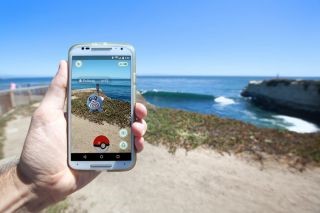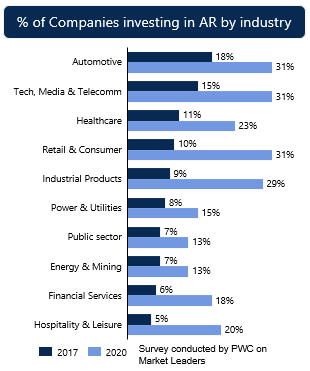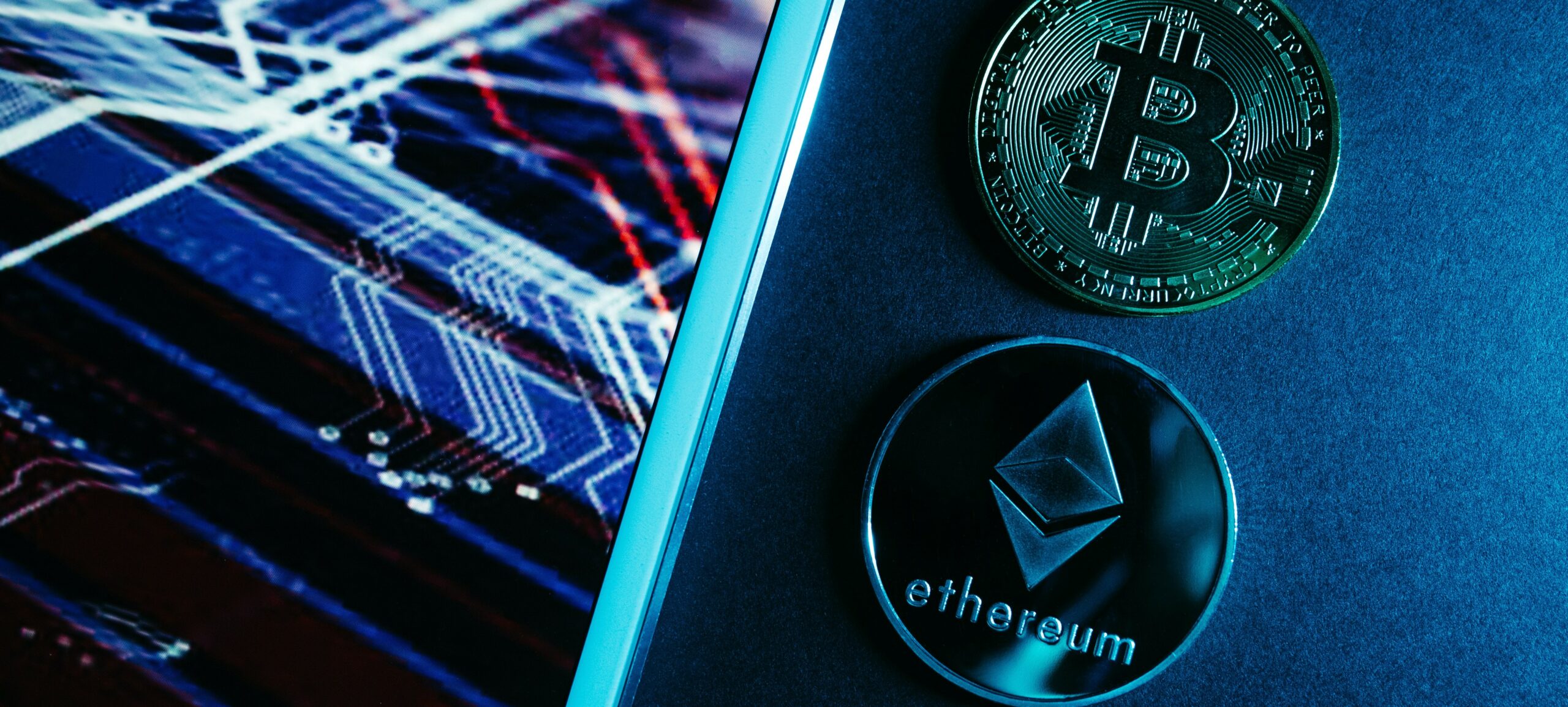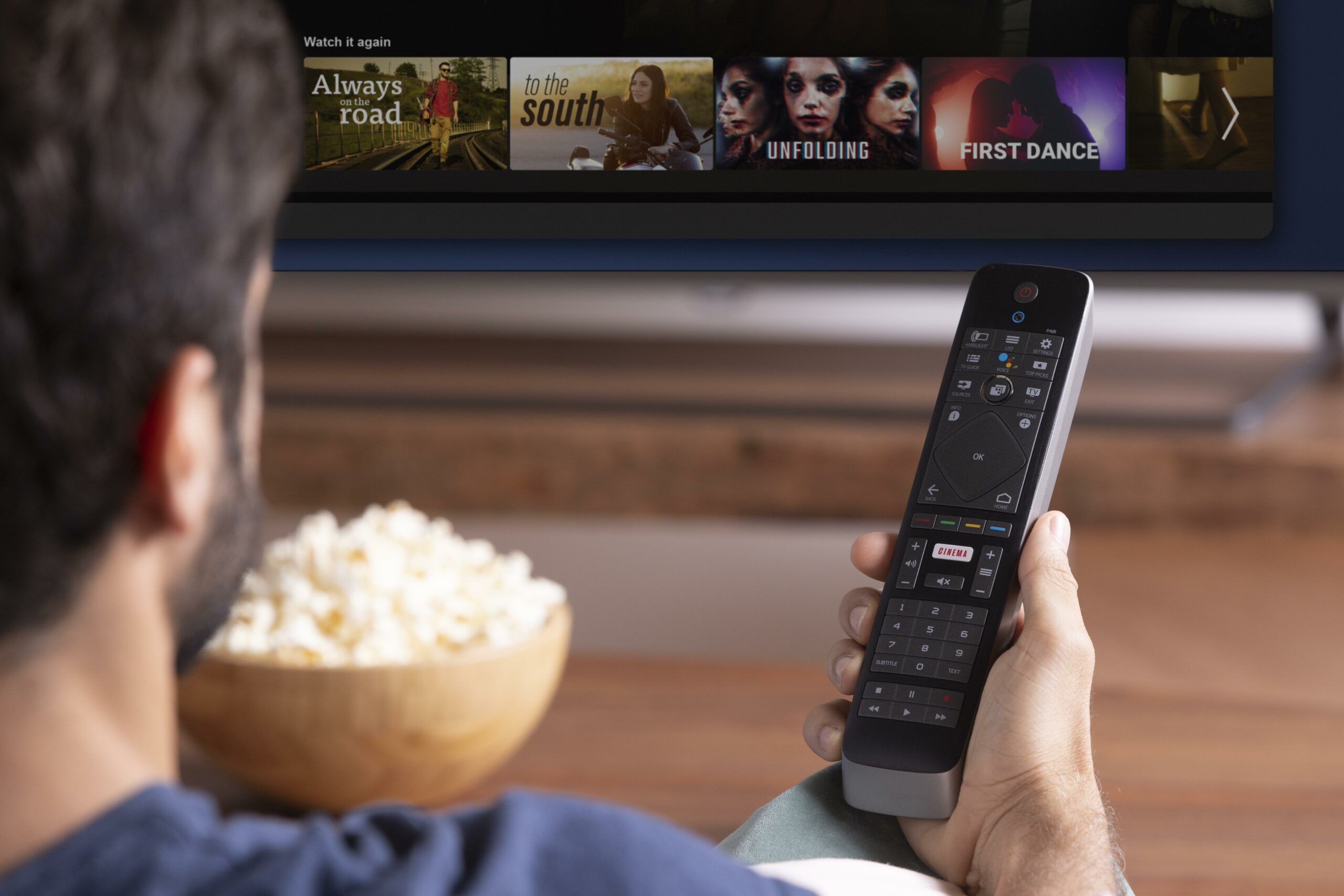Augmented/ Virtual Reality: Market size and applications

Augmented reality (AR) and Virtual reality (VR) are two emerging technologies, with the first prototypes developed in the 1960s, they are evolving now at an increasingly fast pace to become a daily used technology. In recent years, over 75% of Forbes’ “World’s Most Valuable Brands” have been involved in some form of virtual or augmented reality experience for customers or employees or are themselves innovating and developing these technologies. The investment is expected to increase rapidly in the coming few years, after the Covid-19 pandemic, where AR & VR proved to be useful in many areas such as medical diagnoses and remote learning, among others.

Augmented reality (AR) is an interactive, reality-based display environment that takes the capabilities of the computer-generated display, sound, text, and effects to enhance the user’s real-world experience such as in the mobile game Pokémon Go and Snapchat’s filters. Whereas Virtual Reality (VR) uses computer technology to create a wholly simulated environment. VR places the user inside an experience with the help of a headset in contrast to AR which maps holograms over real, physical space through the help of eyeglasses.
While AR/VR technologies have been around for a while, their use was hampered by the lack of supporting technologies such as fast internet, HD display, and content to display. The increase in penetration of smartphones, connected devices, and the 5G network, opens a new horizon for commercial and scientific applications.

The technology was patented in the 1960s, and the first real VR headsets were first introduced by video game companies in the 1990s and took a huge leap in the 2010s with the introduction of HTC (Vive), Sony (PlayStation VR), and Oculus (Rift) – a Facebook company, marking the start of the technology’s commercial use. While VR still holds the larger market share over AR, a survey by Perkins Coie in 2019 on 200 technology leaders showed that 70% of the participants anticipate that the AR market will surpass the VR market in revenues, within 3 – 5 years.
Market size
Together VR and AR had a global market value of $10 bn in 2018, $19 bn in 2020, and forecasted to reach $31 bn by 2023.

The United States has 60% of the total AR/VR businesses in the global market, however, this will soon change. For example, China has been acquiring majority shares in emerging AR/VR companies since 2019. North America’s market share is followed by Western Europe then APAC Regions. The APAC region is set to witness the highest growth forecast. The growth of the VR/AR market is still dependent on the development of complementary technologies such as 5G and hardware required to make AR/VR glasses.
Main sectors and Covid-19 effect
Integration of different technologies like the Tely360’s Ambulance 3rd Eye module, used with the Vuzix Blade, aids in the communication between healthcare personnel working in isolation rooms and physicians outside the room or even in remote places. This system allows the physicians to see and hear what is going on with the patient in the isolation room in real-time. As such, physicians can provide appropriate and timely directions. The sectors

currently investing the most in the AR/VR technologies are Healthcare, Military, Retail, Industrial products, Technology, Logistics, Media & Telecomm, and Gaming. Healthcare is one of the most prominent sectors to benefit from AR, with many applications already on hand and new opportunities are rising because of the Covid-19 situation. Chinese startup “Rokid” is already commercially selling its Glass T1 Thermal glasses, equipped with an infrared sensor and a camera, the glasses allow the wearer to “see” several peoples’ temperatures simultaneously in different colors, such as green (non-alert) and orange (alert). Another example is Vuzix Blade® Smart Glasses a pair of AR glasses developed in Thailand for telehealth, specifically in the care of COVID-19 patients.
Furthermore, AR is also used to assist medical professionals by providing highly efficient and interactive training methods that can streamline the process of learning. Innovations from Microsoft’s HoloLens and the HoloAnatomy augmented reality software at Case Western Reserve University are used to help 185 medical students learn from home.
Another key capability of AR is the ability to overlay a digital virtual user interface on a physical surface. The user can, select actions by tapping on the virtual screen, use hand gestures or verbal commands to interact with the equipment. The provision of such distant interactions is key to reducing the amount of touching required by physical objects that may be used by numerous people. Most museums and other cultural institutions have made virtual tours of their exhibitions available which allows members of the public to experience them from the safety of their homes.
Other sectors investing in AR include Logistics where big players are integrating AR into their process to optimize the logistics planning, process execution, and transportation. DHL has recently tested AR smart glasses with its client Ricoh and reported a 25% increase in performance.
In Retail, AR/VR is being developed more to be part of daily life. AR/VR can be used to make the consumer able to  see how clothes look on them without physically trying them. More examples of how AR/VR are changing the retail sector is the Microsoft and Volvo partnership, where consumers can configure cars at a dealership using HoloLens and Ikea’s new technology which allows customers to see how furniture will fit into their houses without physically trying them.
see how clothes look on them without physically trying them. More examples of how AR/VR are changing the retail sector is the Microsoft and Volvo partnership, where consumers can configure cars at a dealership using HoloLens and Ikea’s new technology which allows customers to see how furniture will fit into their houses without physically trying them.
With a new interest in home entertainment of all kinds, it is a great opportunity for creators of AR/VR systems to promote their products and they are not missing the chance to do so. The gaming industry has been the pioneer in

developing AR/VR, video games were the first to introduce commercial VR headsets in the 1990s and Pokémon Go was the first mainstream game to offer an AR experience, marking the real start of AR’s commercial use where more than 20 million people per day used the Pokémon GO app in 2016.
Key market players include giants like Apple, Microsoft, Sony, Samsung and Google are expected to introduce some of the big breakthroughs in AR in 2021-2023. Emerging startups such as Immersion, Magic leap, and Daqri are gaining more market share through new technologies and applications they produce
Investment Opportunities
Major corporations are now attempting to acquire companies that operate in the AR and VR industry. Such acquisitions strengthen their R&D capabilities and market positioning.
Recently the biggest investment in AR/VR encompassed the investment of $280 million in “Magic Leap” in April 2019 by “NTT DoCoMo” Japan’s biggest cellphone service provider; raising Magic Leap total raised investment to $2.3 billion total. Apple invested $200 million in Corning International in September 2019, also Niantic’s $245 million funding round, tech company Vayyar closing a $109 million Series D round and RealWear’s $80 million investment round.
Below is an example of the VR/AR activities by big names
| Brand | VR/AR Sample Activity |
| Apple | Won a patent for a VR headset and continuing to develop for commercial use |
| Microsoft | Created HoloLens, an augmented reality headset |
| Created Google Cardboard, an inexpensive viewer that turns a mobile phone into a VR experience | |
| Coca-Cola | Created a VR experience for the 2014 World Cup |
| IBM | Obtained patents on virtual universes and augmented realities |
| Samsung | Created Samsung Gear VR headset |
| Toyota | Implemented distracted driver simulation in VR at the New York International Auto Show |
| Created Oculus VR Headset | |
| Disney | Investing in Jaunt VR |
| Amazon.com | Obtained patents for an AR headset |
| BMW | Developing VR goggles to help drivers park by helping them see through the car |
| Intel | Created a VR camera |
| Wal-Mart | Obtained a patent for virtual reality shopping system |
| Verizon | Created a NFL VR experience |
| Honda | Created a “Dream Drive” VR simulation |
| SAP | Created a VR conferencing event |
| Pepsi | Implemented a VR ad campaign at bus stops in London |
Yehia El Ghandour – Senior Associate
Sources:
https://www.hypergridbusiness.com/2015/10/75-of-top-brands-have-vr-projects/
https://www.vrs.org.uk/virtual-reality/history.html
https://na.panasonic.com/us/news/panasonic-develops-worlds-first-hdr1-capable-uhd-vr-eyeglasses
https://link.springer.com/chapter/10.1007/978-3-030-60117-1_34
https://thearea.org/covid-19-how-augmented-reality-is-helping-mitigate-business-impact/
https://next.reality.news/news/25-biggest-ar-investments-2019-0214998/
https://www.mordorintelligence.com/industry-reports/augmented-reality-market
https://www.fortunebusinessinsights.com/augmented-reality-ar-market-102553
https://9to5mac.com/2019/10/21/apple-ar-headset/
https://www.statista.com/statistics/591181/global-augmented-virtual-reality-market-size/
https://www.gminsights.com/industry-analysis/augmented-reality-ar-market
https://www.newgenapps.com/blog/augmented-reality-apps-ar-examples-success/
You may also like
Warning: Undefined variable $content in /var/www/sdomains/nexatestwp.com/infomineo.nexatestwp.com/public_html/wp-content/themes/infomineo/single.php on line 235
Warning: Undefined variable $content in /var/www/sdomains/nexatestwp.com/infomineo.nexatestwp.com/public_html/wp-content/themes/infomineo/single.php on line 235
Warning: Undefined variable $content in /var/www/sdomains/nexatestwp.com/infomineo.nexatestwp.com/public_html/wp-content/themes/infomineo/single.php on line 235
Warning: Undefined variable $content in /var/www/sdomains/nexatestwp.com/infomineo.nexatestwp.com/public_html/wp-content/themes/infomineo/single.php on line 235
Warning: Undefined variable $content in /var/www/sdomains/nexatestwp.com/infomineo.nexatestwp.com/public_html/wp-content/themes/infomineo/single.php on line 235
Warning: Undefined variable $content in /var/www/sdomains/nexatestwp.com/infomineo.nexatestwp.com/public_html/wp-content/themes/infomineo/single.php on line 235








